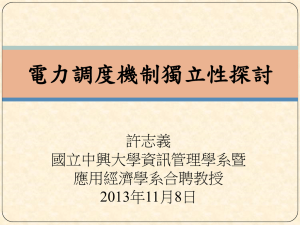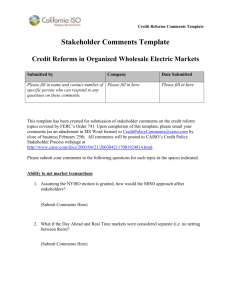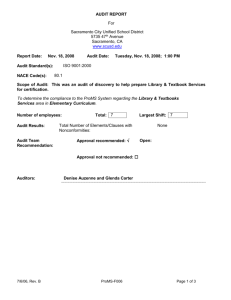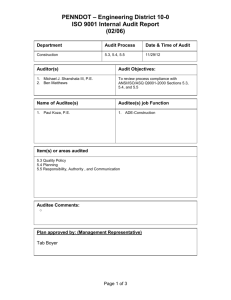ISO Board Template Memo
advertisement
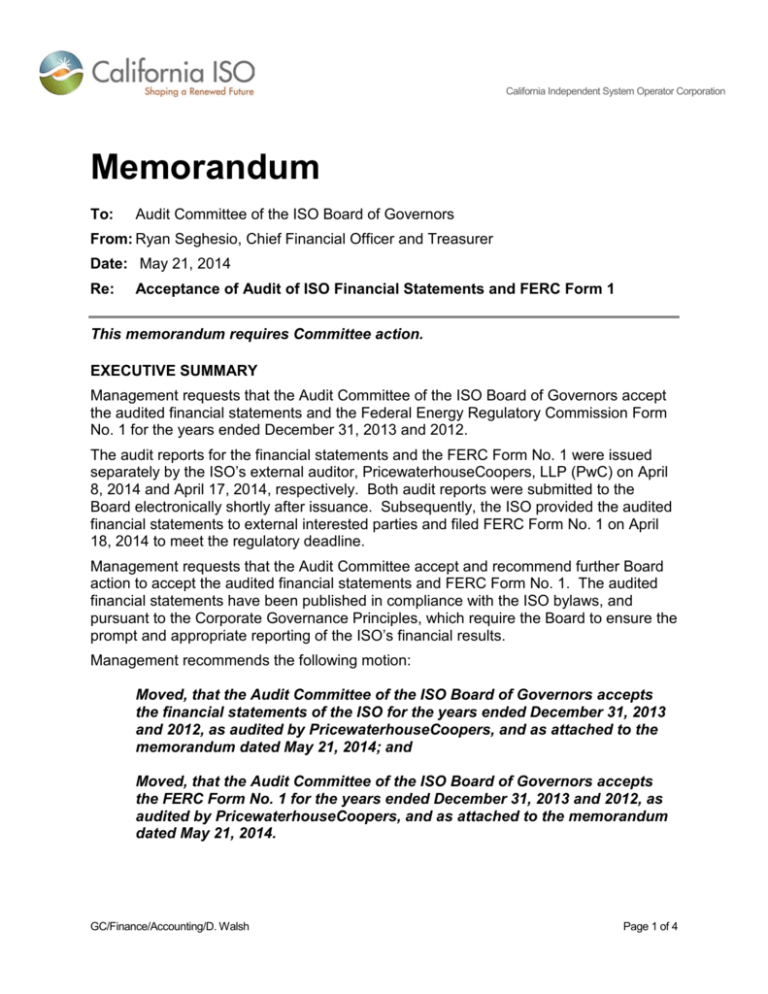
California Independent System Operator Corporation Memorandum To: Audit Committee of the ISO Board of Governors From: Ryan Seghesio, Chief Financial Officer and Treasurer Date: May 21, 2014 Re: Acceptance of Audit of ISO Financial Statements and FERC Form 1 This memorandum requires Committee action. EXECUTIVE SUMMARY Management requests that the Audit Committee of the ISO Board of Governors accept the audited financial statements and the Federal Energy Regulatory Commission Form No. 1 for the years ended December 31, 2013 and 2012. The audit reports for the financial statements and the FERC Form No. 1 were issued separately by the ISO’s external auditor, PricewaterhouseCoopers, LLP (PwC) on April 8, 2014 and April 17, 2014, respectively. Both audit reports were submitted to the Board electronically shortly after issuance. Subsequently, the ISO provided the audited financial statements to external interested parties and filed FERC Form No. 1 on April 18, 2014 to meet the regulatory deadline. Management requests that the Audit Committee accept and recommend further Board action to accept the audited financial statements and FERC Form No. 1. The audited financial statements have been published in compliance with the ISO bylaws, and pursuant to the Corporate Governance Principles, which require the Board to ensure the prompt and appropriate reporting of the ISO’s financial results. Management recommends the following motion: Moved, that the Audit Committee of the ISO Board of Governors accepts the financial statements of the ISO for the years ended December 31, 2013 and 2012, as audited by PricewaterhouseCoopers, and as attached to the memorandum dated May 21, 2014; and Moved, that the Audit Committee of the ISO Board of Governors accepts the FERC Form No. 1 for the years ended December 31, 2013 and 2012, as audited by PricewaterhouseCoopers, and as attached to the memorandum dated May 21, 2014. GC/Finance/Accounting/D. Walsh Page 1 of 4 DISCUSSION AND ANALYSIS Financial Statements Management has prepared the ISO’s financial statements in accordance with generally accepted accounting standards applicable for state and local governmental entities as established by the Governmental Accounting and Standards Board (GASB) for the years ended December 31, 2013 and 2012. Attached is an unqualified audit opinion of the financial statements issued by the ISO’s external auditor, PwC, on April 8, 2014. The financial statements are prepared and audited in accordance with GASB because the members of the Board are appointed by the Governor of the state of California. The ISO is the only FERC jurisdictional entity reporting on a GASB basis. FERC Form No. 1 The FERC Form No. 1 filing is an annual regulatory requirement for major electric utilities, licensees and others. This report is designed to collect financial and operational information from entities subject to FERC jurisdiction. These reports are also considered to be non-confidential public use forms. The ISO is required to file a FERC Form No. 1 because it is considered a major electric utility, which is defined as having (1) one million megawatt hours or more; (2) 100 megawatt hours of annual sales for resale; (3) 500 megawatt hours of annual power exchange delivered; or (4) 500 megawatt hours of annual wheeling for others (deliveries plus losses). The ISO meets the criteria for both (1) and (3) above. Management prepared the FERC Form No. 1 in accordance with the Financial Accounting Standards Board (FASB) reporting requirements for the years ended December 31, 2013 and 2012. Financial Reporting Differences between GASB and FERC The FERC Form No. 1 financial statements are presented differently from the ISO GASB financial statements because FERC requires the use of FASB opinions for the posting of retirement benefit plans, fair value accounting for investments and bond issuance costs. Finance/Accounting/D. Walsh Page 2 of 4 The table below summarizes the reporting differences between the financial statements: Item Net income/(loss) FASB ($39,440,727) GASB ($38,938,717) Difference $502,010 Postretirement benefit plan costs Loss on fair value of investments Bond issuance costs Net Difference $1,700,000 ($2,247,930) $1,445,920 $2,000,000 - $300,000 ($2,247,930) $1,445,920 $502,010 The net result of these reporting differences is that the net loss under FASB is $502,010 higher than under GASB. There are also differences between FASB and GASB regarding the supplemental information required as part of the financial statement presentation. Significant Deficiency in Internal Controls related to Depreciation During the annual audit of the Company’s 2013 financial statements, an error in depreciation expense was discovered for prior years ending December 31, 2011, 2012 and for the current year ending 2013. The error resulted in understated depreciation expense in the net amount of $3.6 million for specific assets associated with the new headquarters facility which was substantially placed in service in 2011. PwC cited this error as a “significant deficiency” in internal controls related to depreciation, (see item two below). In accordance with the Statement of Auditing Standards No. 112, the levels of auditor reporting for internal controls are reflected below in order of severity. Levels of Reporting 1. A control deficiency exists when the design or operation of a control does not allow for the prevention or detection of misstatements in a timely manner. 2. A significant deficiency is a control deficiency that adversely affects our ability to initiate, authorize, record, process, or report external financial data reliably in accordance with GAAP such that there is more than a remote likelihood that a misstatement of our financial statements that is more than inconsequential will not be prevented or detected. 3. A material weakness is a significant deficiency that results in more than a remote likelihood that a material misstatement of our financial statements will not be prevented or detected. Finance/Accounting/D. Walsh Page 3 of 4 This error was deemed by Management to be immaterial to the presentation of the financial statements because readers of the company’s financial statements rely on operating income before depreciation in determining the company’s financial health and its ability to cover debt service and operational costs. An out-of-period adjustment (rather than prior year restatements of the 2011 and 2012 financial statements) was therefore made in 2013 to correct the error and this was disclosed in the audited 2013 financial statements and FERC Form No. 1. Management determined the source of the error as an oversight in current procedures which impacted nine (9) out of a total of 1,200 active company assets. Management has enhanced its current procedures to ensure remediation promptly through more effective controls. The following steps have been put in place to assure that depreciation is calculated accurately in the future: • • Monthly manual recalculation of depreciation of new assets placed in service. The calculated amounts are to be compared to the system generated amounts for these assets. The manual recalculation will take into account the dates-in service to ensure that catch-up depreciation is also calculated by the system. Any discrepancies will be investigated. For any new assets recorded in the fixed asset system at a much later date than their date-in-service, certain procedures will be performed to ensure that the correct flags are enabled so that the system-calculated depreciation is accurate. CONCLUSION Management respectfully requests that the Audit Committee accept the audited financial statements and FERC Form No. 1 for the years ended December 31, 2013 and 2012. Finance/Accounting/D. Walsh Page 4 of 4
